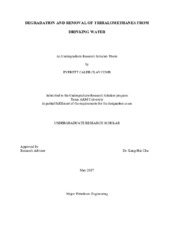| dc.creator | Claycomb, Everett Caleb | |
| dc.date.accessioned | 2017-10-10T20:32:36Z | |
| dc.date.available | 2017-10-10T20:32:36Z | |
| dc.date.created | 2017-05 | |
| dc.date.submitted | May 2017 | |
| dc.identifier.uri | https://hdl.handle.net/1969.1/164591 | |
| dc.description.abstract | A major problem that exists within the field of water treatment is that chemicals must be added to the influent in order to disinfect the water. The most common disinfectant used is chlorine, which has the tendency to react with organic matter in water to form certain disinfection-byproducts (DBPs). These include trihalomethanes (THMs), which are suspected carcinogens found in trace amounts in drinking water. The US Environmental Protection Agency has announced a limit of 0.08 mg/L for the THMs. Previous research has shown that zinc oxide (ZnO) is able to effectively degrade other contaminants, and that UV light can aid in the degradation of certain contaminants by the creation of hydroxyl radicals. This experiment’s aim is to test the effectiveness of ZnO to remove THMs as anew method to eliminate these compounds from drinking water. | en |
| dc.format.mimetype | application/pdf | |
| dc.subject | Trihalomethanes, Degradation, THMs | en |
| dc.title | Degradation and Removal of Trihalomethanes From Drinking Water | en |
| dc.type | Thesis | en |
| thesis.degree.department | Civil Engineering | en |
| thesis.degree.discipline | Petroleum Engineering | en |
| thesis.degree.grantor | Undergraduate Research Scholars Program | en |
| thesis.degree.name | BS | en |
| thesis.degree.level | Undergraduate | en |
| dc.contributor.committeeMember | Chu, Kung-Hui | |
| dc.type.material | text | en |
| dc.date.updated | 2017-10-10T20:32:36Z | |


